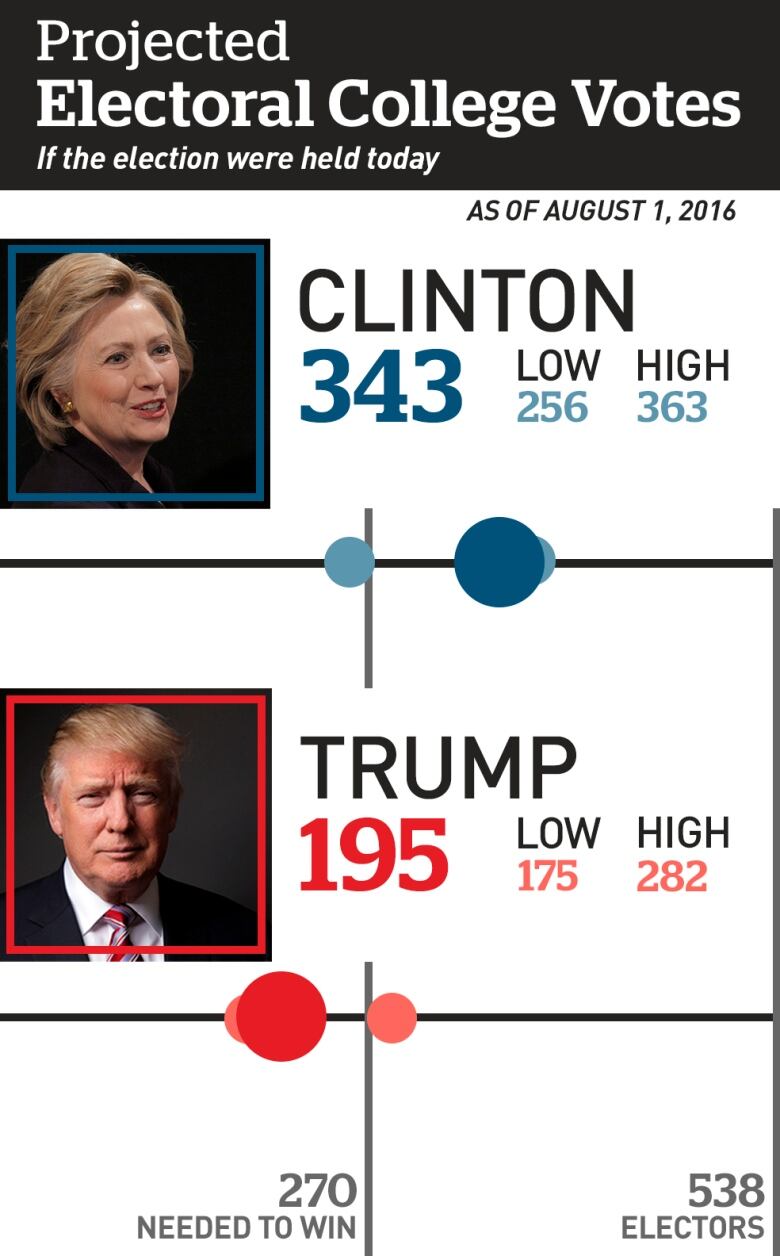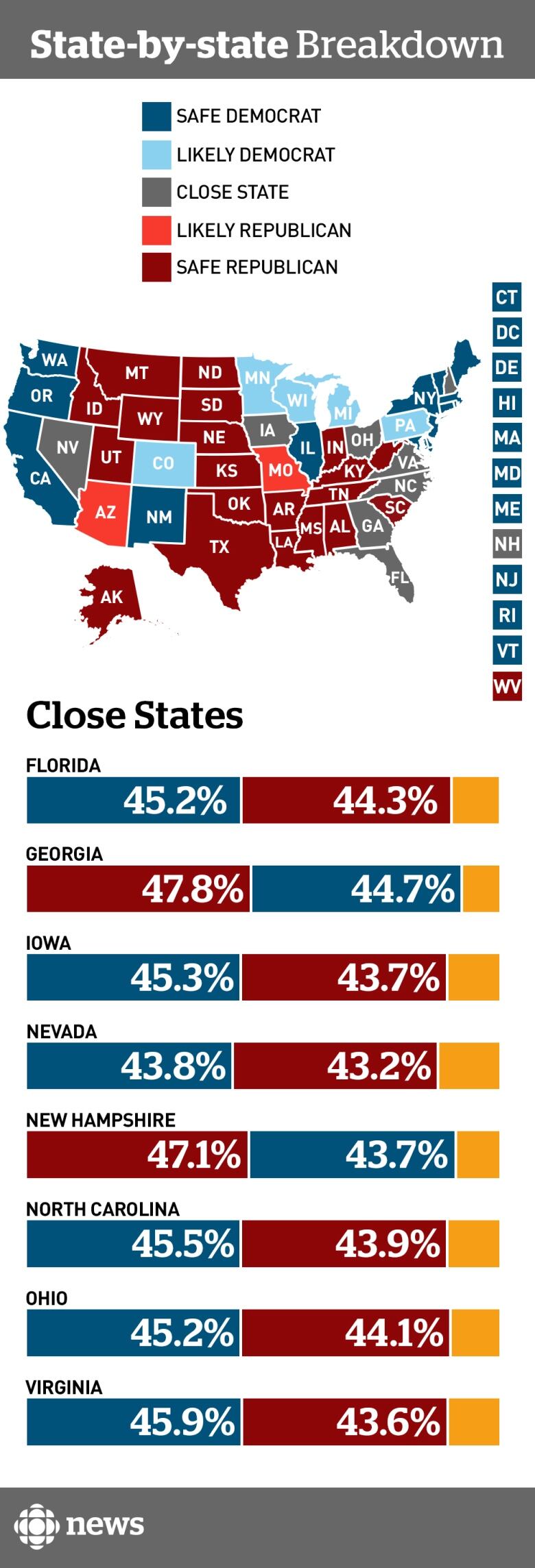Hillary Clinton gets convention bump and a little help from Donald Trump
Margin between 2 presidential candidates swings by almost 9 points in post-convention polls

Hillary Clinton is coming out of last week's Democratic National Convention with soaring poll numbers just as Donald Trump's campaign ishobbled by one self-inflicted wound after another.
In less than a week, Trump has managed to claim that the upcoming election will be "rigged", attackthe father of a slain Muslim American soldier, and claimthat Russia is not involved in Ukraine. And these arejust a few examples of what hasmade the last few days atough one for the Republican nominee.
- Presidential Poll Tracker: Check out the latest numbers
- 'Why are you still endorsing him?' Obama asks Republican leaders
There is no doubt that Trump made some gains in the wake of the Republican National Convention and the naming of Indiana Gov. Mike Pence as his vice-presidential running mate. But if his convention bump was typical, it is beginning to look small compared to Clinton's convention boost.
Based on polls from six polling firms conducted at least partially after the end of the Democratic convention, it appears that Clinton's campaign has received a boost of almost nine points. Support for her candidacy has increased by about 4.5 points, on average, while Trump's has slipped by 4.3 points.
Though convention boosts occur in almost every U.S. election campaign, this one is on the higher side. It might fade quickly, but recent days have not suggested that Trump is on pace to make gains.
Clinton's favourability ratings have also improved, increasing by an average of four points to 41 per cent in recent polls. Her unfavourability remains greater, at an average of 53 per cent, but that is down four points from the pre-convention period.
This has restored her numbers to where they were before the two conventions, when Trump was the more unpopular candidate of the two. But from an average favourability of 38 per cent after the end of the Republican event in Cleveland, Ohio, Trump'sfavourability has now slipped again to just 34 per cent. An average of 59 per cent of Americans say they hold an unfavourable view of the Republican nominee.
Clinton advantage widens
The Presidential Poll Tracker, which reacts to swings in polling more slowly at this stage of the campaign than it will as the election approaches, has shown an improvement in Clinton's standings.

At the height of Trump's post-convention surge, he trailed the Democratic nominee by just two points. But that gap has widened once again to aboutfour points virtually identical to where it stood on July 17, before the Republican convention kicked off.
Support for third party candidates stands at 12.4 per cent. Libertarian candidate Gary Johnson has averaged 7.5 per cent support in the last week of polling, while Green candidate Jill Stein has averaged three per cent.
Based on where the two major candidates stand at the state level, where the election will be decided, Clinton is currently projected to win between 256 and 363 electoral college votes. Trump is projected to win between 175 and 282 votes. A total of 270 votesare required to win the presidency.
(Scroll to the end of this article to see the full breakdown of the electoral college map.)
Clinton leads in most battleground states
The Presidential Poll Tracker model considers eight states to be virtual toss-ups at this stage. Clinton leads in six of them (Florida, Iowa, Nevada, North Carolina, Ohio, and Virginia). Trump is ahead in two others (Georgia and New Hampshire).

On the other hand, New Hampshire and Nevada are trending more towards Trump. In New Hampshire, one recent poll put Clinton and Trump in a tie while another put Trump up by 10 points. Going by national numbers, this is a state that Clinton should be winning by six points.
Nevada, another state Clinton should be winning by six points, has seen one recent poll by Monmouth University giving her an edge of five points, while two polls by Rasmussen have put her ahead by just one point or behind by five.
But the most important battleground states Florida, North Carolina, Ohio, and Virginia, along with Pennsylvania are currently leaning towards Clinton. If she continues to see her poll numbers improve in the wake of last week's convention in Philadelphia, her advantage in these battleground states will widen as well.
And if Clinton manages to hold on to most of her over-sized convention bounce in the coming weeks, Trump may have too much ground to make up.

ThePresidential Poll Trackerincludes all published mainstream surveys, a list of which can be foundhere. The polls are weighted by sample size and date, as well as the reliability of eachpollster as rated byFiveThirtyEight.com. The electoral college is projected by applying the same weighting standards to state-level polls and combining this with a uniform swing model, based on how the current national polling average compares with the 2012 presidential election. Surveys included in the model vary in terms of sample size and methodologyand have not been individually verified by the CBC.A full methodological explanation can be found here.












_(720p).jpg)


 OFFICIAL HD MUSIC VIDEO.jpg)
.jpg)



























































































